Game theory is seen as a system that can be applied to any aspect of life; it is a branch of economic theory that consists of a set of models and concepts meant to represent how you think about strategic interacting situations.
Doctors, mathematicians, and others write game theory books as a theoretical foundation for people envisioning social issues amongst themselves. They all regard game theory as the science of strategy or, at the very least, the optimal decision-making of independent and competing actors in a strategic situation.
While most publications on the subject are too abstract or basic for mathematicians to understand, a few others have been written with a clear understanding of what the term “game theory” entails.
In some instances, your rational behavior is contingent on how you perceive or assume the other participants in the situation will act.
That is, you want to put yourself in the shoes of the other player or players, or, to put it another way, you want to enter their minds, It is critical for you to make a decision based on this information. It’s not like deciding whether or not to bring an umbrella when all you have to consider is the possibility of rain later in the day.
The former, on the other hand, can be done in a number of ways, and you can likewise respond in a number of ways. Game theory is distinct in that it has long been assumed that when players engage with one another, they do it in a reasonable manner.
A clear example of game theory is the most known “Prisoner’s Dilemma”
Prisoner’s Dilemma Example
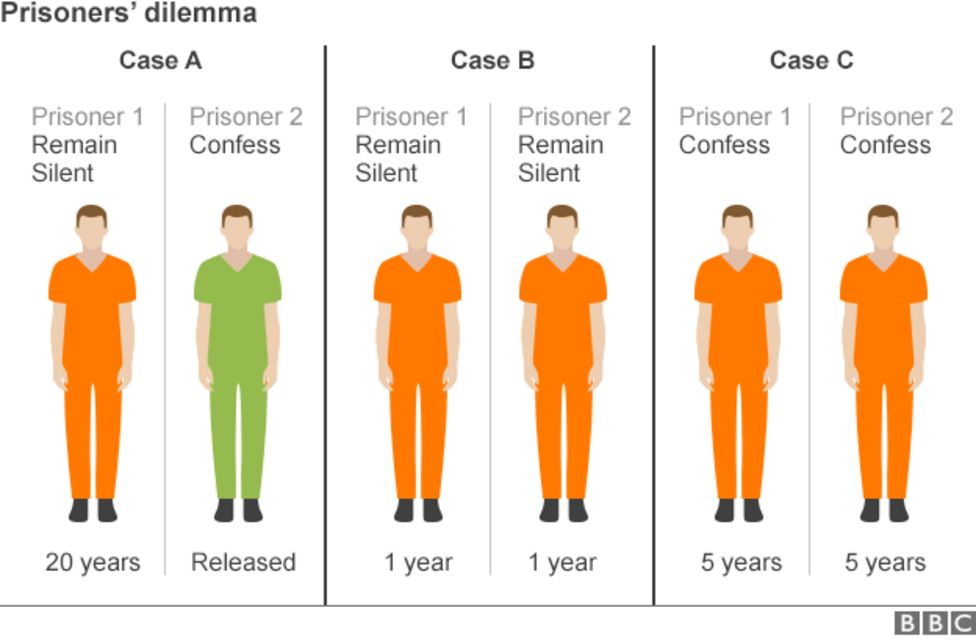
Two people are captured, detained, and a date for their trial is set.
The prosecutor for the case addresses each prisoner individually and offers an incentive: if you confess against your co-conspirator, all charges against you will be dropped, and your confession will be used to convict the other.
He would face a sentence of twenty years in prison if convicted. If you don’t say anything and your friend confesses, you’ll be found guilty and sentenced to 20 years in prison, while he’ll be released.
You will be convicted if you confess, but only for five years. If you remain silent, you will be convicted and sentenced to one year in prison.
The prisoner’s dilemma arises from the fact that each prisoner’s outcome is dependent on the acts of the other.
Individually, admitting is the best alternative; yet, if both confess, the punishment is harsher than if they both keep their mouths shut. They must decide, and their choices will affect each other.
The phrase “tit for tat” is the most effective technique for resolving a prisoner’s dilemma. Anatol Rapoport coined the term “tit for tat,” a strategy in which players in an iterated prisoner’s dilemma do the same action as their opponent in the previous turn.
For example, if a player is provoked, the player will retaliate; if the player is not provoked, the player will collaborate.
See What Others Read Too: 21 Best Electrical Engineering Books | Undergraduates, Masters, PhD
WHAT IS GAME THEORY ALL ABOUT?
The mathematical study of decision-making, conflict, and strategy in social circumstances is known as game theory. It makes clear how we engage / Converse during critical decision-making processes.
- Any set of circumstances in which the outcome is determined by the acts of two or more decision-makers is a game.
- Players: Within the context of the game, a strategic decision-maker
- The strategy is a comprehensive plan of action that a player will employ in response to various events that may arise throughout the game.
- Payoff: The fixed amount of money a player earns for achieving a particular result. (It can be expressed in any measurable form, such as dollars or utility.)
- The information available at a specific stage in the game is referred to as the information set (The term information set is usually applied when the game has a sequential component.)
- Equilibrium: In a game, when both players have made their decisions, and a result has been reached.
Assuming a dealer wants to sell the car and has a set price, he can’t go below without losing money.
The auto dealer’s negotiating strategy is based on the fact that you desire the car, that he may sell it to another client, that selling the car will earn him acclaim, and the break-even threshold below which he can’t go lower.
You negotiate to owe to the fact that the dealer wants to sell the car, that there is a profit margin into which you can bargain to reduce the car’s price, and that the dealer is aware that you being in his office indicates that you are looking to buy a car.
See Also: 12 Best Gre Prep Books of 2022
NASH EQUILIBRIUM
Nash equilibrium is a response to a non-cooperative game in which players have no reason to change their strategy because they know what their opponents are doing. Changing a player’s approach after reaching Nash equilibrium will make them worse.
When both players embrace the confess strategy in the Prisoner’s Dilemma game, either player is not motivated to switch to a “deny” strategy unless the other player also denies it.
The most serious flaw in game theory, like most other economic models, is that it is based on the premise that people are rational, self-interested, and utility-maximizing actors.
Of course, we are social beings who work together and care about others’ well-being, frequently at our own price.
Game theory cannot account for the reality that, depending on the social context and who the participants are, we may fall into a Nash equilibrium in certain scenarios and not in others.
Consider the following scenario: Harry and Henry are playing a game. Both players can choose strategy A to receive $1 or strategy B to lose $1 in this easy game. Both players adopt approach A and earn a $1 payout, indicating that outcome A is a Nash equilibrium.
Read About: 20 Best IELTS Preparation Books in 2022 | Get PDF Free
THE IMPACT GAME THEORY HAS ON ECONOMICS AND BUSINESS
By addressing critical flaws in previous mathematical economic models, game theory ushered in a revolution in economics. Neoclassical economics, for example, struggled to comprehend entrepreneurial anticipation and could not deal with imperfect competition.
The focus of game theory shifted away from steady-state equilibrium and toward the market process.
Game theory is used in business for modeling competing behaviors among economic agents. Businesses frequently face a number of strategic decisions that impact their potential to generate profit.
Businesses may be faced with decisions such as whether to retire existing products or develop new ones, whether to cut pricing in comparison to the competition, or whether to implement new marketing techniques.
Game theory is frequently used by economists to better explain the behavior of oligopolistic firms. When companies engage in particular practices, such as price-fixing and collusion, it can assist forecast the likely effects.
TYPES OF GAME THEORIES
There are 5 types of game theories, which are;
- Co-operative and Non Co-operative Games
- Extensive Form and Normal Form Games
- Sequential Move Games and Simultaneous Move Games
- Zero-sum, constant-sum, and non-zero-sum games
- Games that are both symmetric and asymmetric

1. Co-operative and Non Co-operative Games:
Negotiations and agreements between players are used in cooperative games to persuade participants to pursue a specific approach.
Non-cooperative games, on the other hand, are those in which the players choose their own strategy to maximize their profit. The prisoner’s dilemma is the best example of a non-cooperative game.
Non-cooperative games yield precise outcomes. This is because non-cooperative games necessitate a thorough examination of a topic.
2. Extensive Form and Normal Form Games:
Extensive form games are those in which the game’s description is written as a decision tree. Also, extensive form games to aid in the portrayal of random events. The names of the participants are represented on separate nodes in these games, which have a tree-like structure.
The term “normal form game” refers to a game that is described as a matrix. In other words, normal form games are those in which the payout and strategies of a game are described in a tabular format.
The dominating strategies and Nash equilibrium can be identified using normal form games. The matrix in normal form games depicts the strategies used by the various players in the game, as well as the probable outcomes.
3. Sequential Move Games and Simultaneous Move Games:
In sequential games, however, participants do not have extensive information of other players’ strategies. For instance, a player may know that the other player will not utilize a single strategy, but he or she may not know how many methods the other player will employ.
Simultaneous games are depicted in a standard format, whereas sequential games are depicted in a more detailed format.
Simultaneous games are those in which two players’ moves (and thus their strategies) are made at the same time. Players in a simultaneous move are unaware of the movements of other players.
Sequential games, on the other hand, are those in which players are aware of the moves of other players who have already chosen a strategy.
4. Zero-sum, constant-sum, and non-zero-sum games:
The sum of the results of all players in a constant sum game remains constant even if the outcomes are different. A zero-sum game is a constant sum game in which the sum of all players’ outcomes is zero. Different players’ strategies cannot affect the available resources in a zero-sum game.
Furthermore, in a zero-sum game, one player’s gain is always equivalent to the loss of the other. Non-zero sum games, on the other hand, are those in which the sum of all players’ outcomes is not zero.
By adding one dummy player to a non-zero-sum game, it can be converted to a zero-sum game. The net earnings of the players outweigh the losses of the fake player. Chess and gambling are two examples of zero-sum games.
In these games, one player’s success results in the loss of the other. Non-zero games, on the other hand, are cooperative games. This is due to the fact that in cooperative games, everyone either wins or loses.
5. Games that are both symmetric and asymmetric:
In symmetric games, all participants use the same strategy. Symmetry can only occur in short-term games since the number of possibilities available to a player rises in long-term games.
In asymmetric game, the outcomes are determined by the strategies employed, not by the players. In symmetric games, the decisions remain the same even if the players change. The prisoner’s dilemma is an example of symmetric games.
On the other hand, asymmetric games are those in which the players’ strategies diverge. In asymmetric games, the tactic that benefits one player may not be equally helpful to the other player.
In asymmetric games, however, decision-making is influenced by the players’ many sorts of strategies and decisions.
The entry of a new business into a market is an example of an asymmetric game since various organizations utilize different methods to enter the same market.
APPLICATION OF GAME THEORY TO REAL LIFE SITUATION
Game theory is an area of economics that has gotten a lot of press recently. The name “theory of games” was excellent as a marketing strategy.
The word “game” conjures up images of fun and friendship. It provides folks with a positive sensation. It reminds us of chess, checkers, and other children’s games.
Even though you may be dealing with concerns such as nuclear deterrence, the connotations are light and not heavy.
It is an appealing idea for people to believe that they can apply something essential to problems that are extremely complex, such as the economic crisis or nuclear deterrence.
THE 15 BEST GAME THEORY BOOK’S IN 2023
1. Finite and Infinite Games:
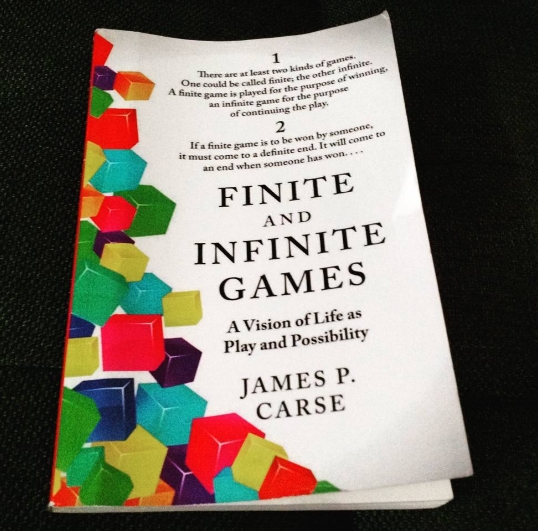
“One could be considered finite; the other infinite,” writes James P. Carse at the start of this remarkable book. A finite game is played to win, while an endless game is played to continue to play.”
Finite games are the regular competitions that are performed to be won, which is when they come to an end. Infinite games, on the other hand, are more mysterious. Their goal isn’t to win but to keep the game going. The rules, the boundaries, and even the players are all subject to alteration as long as the game is never permitted to end.
What are Infinite games, and how do you play them? What impact do they have on our finite gameplay? When we play, do we play indefinitely or indefinitely? And, more importantly, how do infinite games alter how we spend our lives?
Carse deftly investigates these issues, eliciting a world of observation and understanding from his distinctions, noting where, why, and how we play, finitely and indefinitely.
He examines our universe, from the finite games of the playing field and board to the vast games of culture and religion, illuminating and transforming all we think we know.
Author: James P. Carse
Publisher: Free Press (January 5, 2013)
Pages: 160 pages
Review:
Carse’s work is divisive since it is written in an aphoristic style. Some people think it’s brilliant, others think it’s gibberish, and yet others believe there’s something deeper behind it but can’t put their finger on it, supposing they’re not smart enough to understand it.
The book is essentially about competition (limited games) vs. cooperation (infinite games), and it is written in aphorisms with no arithmetic or game theory references.
Carse, a theologian rather than a mathematician, identified patterns of interaction that he didn’t have the mathematical tools to explain. The result is a long list of fortune cookie-style explanations.
Get this book here!
2. Principles; Life and work:

Dalio explains what he’s learned throughout his incredible career in Principles. He claims that life, management, economics, and investing can all be systemized into rules and understood like machines.
Dalio lays out the most successful ways for individuals and companies to make decisions, approach difficulties, and develop strong teams in the book’s hundreds of practical lessons, which are structured around his cornerstones of “radical truth” and “radical transparency.”
He also discusses the company’s unique tools for bringing the idea of meritocracy to life, such as developing “baseball cards” for all employees that condense their strengths and flaws and using automated evaluations.
He also discusses the company’s unique techniques for bringing the idea of equality to life, such as developing “baseball cards” for all employees that condense their strengths and shortcomings and using computational decision-making processes to make believability-weighted decisions.
While Principles is chock-full of innovative ideas for businesses and institutions, it also provides a simple, uncomplicated method to decision-making that Dalio feels anybody can use, regardless of their goals.
Author: Ray Dalio
Publisher: Schuster & Simon; Illustrated edition (2017 September 19)
Pages: 592 pages
Reviews:
The book is both educational and emotionally affecting. Mr. Dalio is preaching for individuals to have a sense of humility and introspection, a capacity to open themselves up to appreciate pointed criticism and utilize it to develop below what may appear to be a clinical, dispassionate attitude.
The over 600-page book opens with the author’s background, including the creation of Dalio’s very successful investment firm, Bridgewater Associates.
Half memoir, part strategic plan, Dalio draws on his own experiences to offer advice on achieving success, constantly emphasizing the importance of uniqueness and personal aspirations.
This isn’t just a book for the rich and powerful. Dalio’s meticulous strategy concentrates on what he refers to as “radical” facts and transparency. It can be applied to the careers of powerful CEOs, rising executives, long-serving grunts, and fresh-faced rookies.”
Get this book here!
3. Who Gets What – and Why:
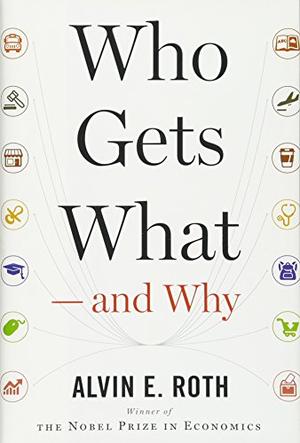
Most economics research focuses on commodity markets, in which the price of a thing connects sellers and purchasers.
But what about other “goods,” such as a place in Yale’s freshmen class or a job at Google? You’ve participated in a market if you’ve ever applied for a job or hired someone if you’ve ever applied to college or guided your child into a good kindergarten if you’ve ever asked someone out on a date or been asked out.
This matches market terrain, where “sellers” and “buyers” must choose each other, and price isn’t the primary criterion for who gets what.
Nobel laureate Alvin E. Roth reveals the hidden matching markets around us in Who Gets What—and Why, teaching us how to detect a good match and make better informed, confident judgments.
Author: Alvin E. Roth
Publisher: Mariner Books/ Eamon Dolan; Reprint edition (2016 June 7)
Pages: 272 pages
Review:
Practical as well as theoretical. Understanding how matching markets work can make it easier for readers to navigate them. Readers interested in general economics and business collections will find this book a good match.
Roth challenges traditional economics in this book, filled with wit, charm, common sense, and uncommon wisdom, emphasizing that markets can often be more accessible and work much better when carefully chosen rules govern them.
Get the book here!
4. Game Theory 101:

The Complete Textbook of Game Theory gives a straightforward, games-centered approach to strategic form (i.e., matrix) and extensive form (i.e., game tree) games. This textbook provides games of increasing complexity from the first to the last session and then teaches the game theory tools needed to solve them.
Game Theory 101: The Complete Textbook is ideal for students studying beginning game theory, intermediate microeconomics, and political science.
Author: William Spaniel
Publisher: Independent Publishing Platform CreateSpace (2011 September 3)
Pages: 276 pages
Review:
This is a beautifully worded, easy-to-understand explanation of the game theory and some arithmetic concepts.
It’s great for people who aren’t math specialists, although it does require a basic understanding of algebra. linking game theory principles with traditional game examples
The math explains how computations are performed, as well as some of the assumptions and constraints of game theory.
It’s a comprehensive resource for novices, and it’s best to go over all of the examples to gain a sense of the principles.
The concepts discussed in the book aren’t intuitively straightforward, but with the help of graphics and various examples, even the most challenging situation becomes understandable.
Get the book here!
5. Reality is Broken:

Jane demonstrates how we can use the power of games to solve real-world problems, ranging from social issues like depression and obesity to global issues like poverty and climate change, in this ground-breaking book, and introduces us to cutting-edge games that are already changing the business, education, and nonprofit worlds.
Reality Is Broken is a book for gamers and non-gamers alike, demonstrating that individuals who can comprehend, make, and play games will have a bright future.
Author: Jane McGonigal
Publisher: Illustrated edition; Penguin Books (2011 December 27)
Pages: 416 pages
Review:
Reality is Broken is an engaging examination of why we enjoy playing games so much and why, rather than being a diversion from reality, technology-driven games are increasingly giving solutions to our everyday problems.
McGonigal’s book, despite her knowledge, is never excessively technical, and, like a good computer game, anyone, regardless of gaming background, is likely to get caught in.
McGonigal offers an interesting and provocative, if disturbing, statement that contributes to our understanding of the fascination and potential power of digital games. McGonigal is a clear, meticulous writer with well-reasoned views, and numerous psychological studies support assertions.
Get the book here!
6. Thinking, Fast and Slow:

Kahneman engages the reader in a spirited discussion about how we think, revealing where we can and cannot trust our instincts and how we might gain from slow thinking.
He provides practical and insightful insights into how we make decisions in our professional and personal lives, as well as how we can utilize various tactics to avoid the mental blunders that frequently get us into difficulty. Thinking, Fast and Slow is a modern classic, an indispensable book that has influenced millions of people’s lives. For almost a decade, it has topped bestseller lists.
Author: Daniel Kahneman
Publisher: Straus, Giroux, and Farrar; 1st edition (2013 April 2)
Pages: 499 pages
Review:
It’s an incredibly rich book: lucid, insightful, and full of intellectual surprises as well as self-help value. It never ceases to entertain.
[Thinking, Fast and Slow] is a fantastic book. It is so rich and fascinating to anyone with even a passing curiosity in the inner workings of their own mind that any summarization would be ludicrous.It is a work of art, a brilliant and engrossing intellectual adventure written by one of the world’s best psychologists and deepest thinkers.
Get the book here!
7. Co–opetition:
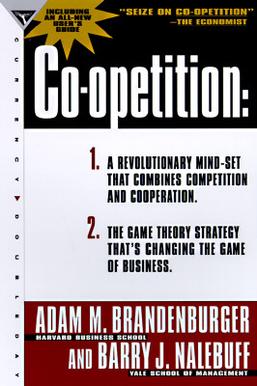
Co-opetition is a corporate approach that combines the benefits of competition and collaboration, going beyond the classic rules of competition and cooperation. Co-opetition is a cutting-edge, high-profit method of leveraging company connections.
Authors Brandenburger and Nalebuff prepared a book that is enlightening and educational for managers willing to shift their firms into a new mindset by formulating plans based on game theory.
Authors: Barry J. Nalebuff and Adam M. Brandenburger
Publisher: Currency Doubleday; 1st edition (December 29, 1997)
Pages: 304 pages
Review:
The writers cover a lot of material regarding applying Game Theory to business and how corporations collaborate to expand a market and compete to split market share.
Co-opetition is a seminal business book that uses game theory to argue that enterprises should collaborate rather than compete since the two combined processes will result in a larger pie that can then be divided up to provide win-win outcomes for all parties.
Get the book here!
8. The Complexity of Cooperation:
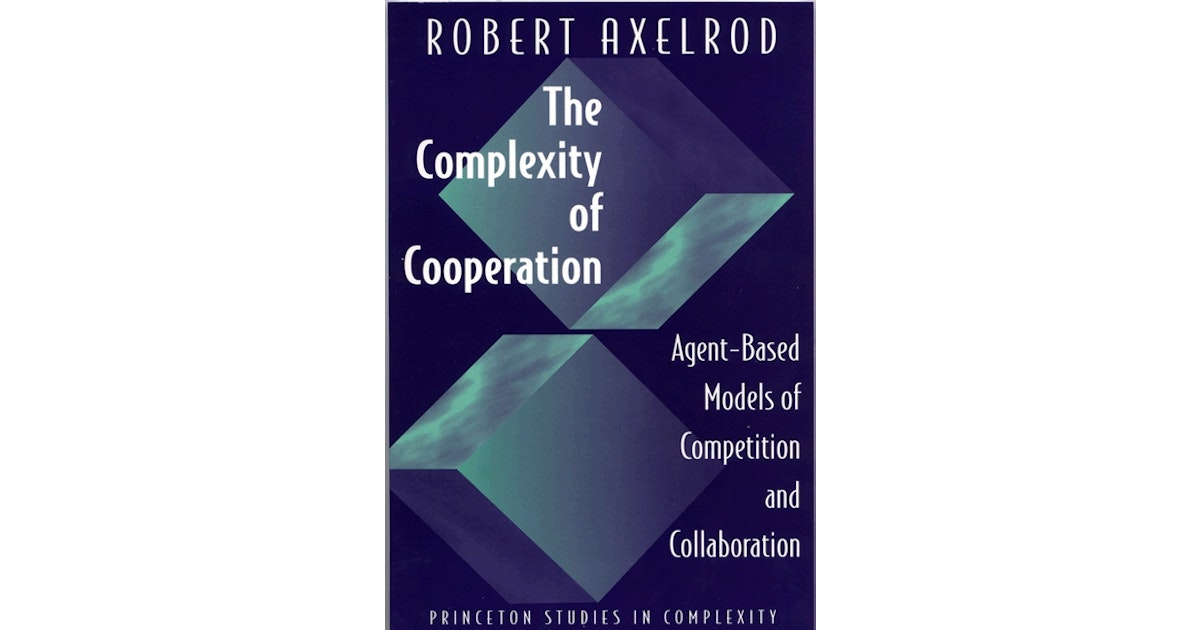
The articles go beyond the core paradigm of the Prisoner’s Dilemma to look at a wide range of topics, such as how to deal with perception and implementation problems, how norms emerge, and how new political players and shared cultural areas can emerge.
They share the agent-based modeling methodology, a powerful technique that specifies individual interaction rules and employs computer simulation to uncover emergent aspects of the social system.
All social scientists who are interested in questions of collaboration and complexity should read The Complexity of Cooperation.
Author: Robert Axelrod
Publisher: Princeton University Press (August 18, 1997)
Pages: 248 pages
Review:
The Evolution of Cooperation, by Robert Axelrod, was praised around the world for the rich results of its basic model. The Complexity of Cooperation brings together the many fruits of more than a decade of research, methodically ‘complexifying’ his original model.
His style is as clear and entertaining as his ideas. His excitement as he reveals each new discovery is contagious. This book isn’t just necessary; it’s also entertaining.”
Get the book here!
9. The Joy of Game Theory:

Game theory is a fascinating subject, and this book will teach you how to comprehend it and put it into practice through a series of scenarios and over 30 pictures. There are two main goals for this work.
(1) To aid in the recognition of strategic games such as the Prisoner’s Dilemma, Bertrand Duopoly, Hotelling’s Game, Chicken Game, and Mutually Assured Destruction.
(2) To demonstrate how to make better judgments and modify the game, a powerful notion that may turn no-win scenarios into win-win ones.
Author: Presh Talwalkar
Publisher: CreateSpace Independent Publishing Platform (August 8, 2014)
Pages: 154 pages
Review:
You’ll learn how to bargain more effectively by making your threats credible, limiting possibilities or burning bridges when necessary, and thinking of new approaches to get better results.
Game theory is considerably more than board games and gambling, as these objectives suggest.
It all appears to be so straightforward, but the intricacy of game theory is shown by that definition. It may take only a few seconds to grasp the basics of game theory, but it takes a lifetime to appreciate and master it.
Get the book here!
10. The Art of Strategy:

The term “game theory” refers to a methodical approach to strategic planning. It’s the skill of foreseeing your opponent’s next movements while fully aware that your opponent is attempting to do the same to you.
Though certain aspects of game theory are straightforward, most of it is counterintuitive, and it can only be understood by gaining a new perspective on the world.
The authors demonstrate how practically every commercial and personal contact has a game-theory component using a varied array of interesting case studies drawn from pop culture, TV, movies, sports, politics, and history.
Mastering game theory can help you succeed in business and in life, and this engaging book will help you get there.
Author: Barry J. Nalebuff and Avinash K. Dixit
Publisher: Illustrated edition; W. W. Norton & Company (2010 January 4)
Pages: 512 pages
Review:
This book gives the sense of a university course taught by captivating professors who have a special capacity to make even the most difficult concepts understandable and fun.
It’s better to be a good strategist than a terrible one, and the authors promise that “this book will help you enhance your skills at developing and using successful ideas.”
Everyone can benefit from strategic thinking. We all make decisions, and many of them are influenced by the decisions of others.
This book on strategy, written from the perspective of game theory, can help you make better decisions in many areas of your life.
Get the book here!
11. Evolution of Cooperation:

Robert Axelrod, a political scientist, attempts to answer this topic in his book The Evolution of Cooperation.
He organized the infamous Computer Prisoners Dilemma Tournament in 1980, which aimed to determine the best survival strategy in a specific game.
The most basic method, a cooperative program dubbed Tit for Tat, repeatedly defeated the competition. In other words, cooperation, rather than unbridled rivalry, appears to be our best chance of surviving.
The Evolution of Cooperation is a must-read for leaders and decision-makers. It explains how cooperative ideas can help us think more clearly, from military strategy to political elections to family relations.
Author: Robert Axelrod
Publisher: Revised edition; Basic Books (2006 December 5)
Pages: 264 pages
Review:
As the title suggests, this book focuses on cooperation, specifically how it can evolve in a dispersed society that wants individual self-interest maximization. The book is explained in two parts.
The first examines collaboration by analyzing computer tournaments using game theory. This includes the numerous strategies employed as well as the ones that were most successful.
The second half explores the ramifications of the previous portion’s results, as well as real-world applications in domains like biology, politics, and sociology.
While the first portion is a little boring and abstract, the second section solidifies the principles and is extremely useful and practical.
Get the book here!
12. Mostly Harmless Econometrics:

Mostly Harmless Econometrics includes econometric fundamentals as well as key novel extensions such as regression-discontinuity designs and quantile regression, as well as how to get standard errors right.
Jörn-Steffen Pischke and Joshua Angrist show why more advanced econometric procedures are often useless and dangerous.
The applied econometric approaches presented in this book are simple to apply and applicable to a wide range of current social science topics.
- An irreverent look at the fundamentals of econometrics.
- A emphasis on the most often used tools by applied researchers.
- Regression-discontinuity designs, quantile regression, and standard errors are covered in detail.
- There are numerous empirical instances.
- A resource that is both clear and succinct and has a wide range of applications.
Author: Jörn-Steffen Pischke and Joshua D. Angrist
Publisher: 1st edition; Princeton University Press (2009 January 4)
Pages: 392 pages
Review:
What an enthralling and practical book! Econometrics in empirical research is as much an art as it is a science.
Apart from the colorful literary style, what sets Mostly Harmless Econometrics apart from other graduate-level econometrics publications is that the writers are longtime practitioners of applied microeconometrics.
Therefore they speak frequently and insightfully about the field. Working in the same department as Angrist or Pischke and being able to ask their assistance should be a fantastic experience.
The next best thing is having this book nearby. You won’t always do what Angrist and Pischke would do if you consult the book to see ‘What would Angrist and Pischke do?’ about econometric issues you encounter in your own research, but I bet you’ll always benefit from getting their perspective.
Get the book here!
13. MicroMotives and MacroBehaviour:

Despite the fact that Micromotives and Macrobehavior were first published almost twenty-five years ago, the stories it tells still feel current today.
And the subject of these stories is more essential than ever: how seemingly insignificant individual decisions and acts can have major unforeseen effects on a large community.
Thomas C. Schelling, for example, demonstrates how a little but not a malevolent preference for having neighbors of the same race gradually leads to entirely segregated populations.
Author: Thomas C. Schelling
Publisher: Revised edition; W. W. Norton & Company (2006 October 17)
Pages: 288 pages
Review:
Many economists’ perceptions of the relationship between competitiveness and social welfare have changed due to Schelling’s [book].
Get the book here!
14. Natural Justice:

This book offers the groundwork for a “moral science.” Binmore investigates ethical issues using game theory as a systematic tool. In a game-theory framework, he reinterprets old social contract ideas and generates new insights into key concerns in social philosophy.
Binmore begins with individuals, rational decision-makers with the ability to empathize with one another, in contrast to previous work in moral philosophy that depended on abstract notions such as “societal well-being” and “moral duty.”
Any social arrangement that requires them to behave against their interests will become unstable and will eventually be replaced by another until one is discovered that includes acts that are beneficial to all those involved.
Author: Ken Binmore
Publisher: Illustrated edition; Oxford University Press (2011 January 28)
Pages: 224 pages
Review:
Ken Binmore has developed an engaging book that uses evolutionary theory to derive moral concepts of justice, equity, and other conduct.
Societies that achieve a more efficient and ‘fairer’ equilibrium, according to his idea, are more likely to survive due to a mix of genetic and cultural selection. He is, in my opinion, properly harsh in his criticism of Kant’s and other philosophers’ very arbitrary moral answers.
The book is inventive but divisive, and it is a truly unique and fresh approach expressed primarily in non-technical language. It should be read and debated widely. I believe it will have a substantial impact on future discussions of moral standards.
Get the book here!
15. Prisoner’s Dilemma:

Prisoner’s Dilemma is a remarkable work of science writing that combines a biography of the brilliant and tragic von Neumann, a history of critical Cold War periods, as well as a look at game theory’s current influence on public policy.
The most important aspect of Prisoner’s Dilemma is that it tells the compelling story of a revolutionary theory that has been heralded as a watershed moment in twentieth-century thought.
The “prisoner’s dilemma,” a distressing and mind-bending game in which two or more people may forsake the common good for personal gain, is a troubling and mind-bending game.
Author: William’s Poundstone
Publisher: First Edition Thus; Anchor (1993 January 1)
Pages: 294 pages
Review:
The book is primarily about the employment of game theory during the Cold War and John Von Neuman’s life, but it also makes numerous other links. The link to the economic dilemma known as “the Free Rider Problem” is highlighted, for example.
Cooperation is discussed as an evolutionary need. A major focus is on the psychology of decision-making. The relationship between different styles of playing and one’s political opinions was particularly intriguing.
Get the book here.
CONCLUSION
Learning game theory not only enhances your game, but it also improves your mental toughness and negotiation abilities, boosts your tolerance level, makes you more compassionate, and improves the overall quality of your life (day-to-day life, professional and personal life.)
REFERENCES
- bbc.com
- fivebooks.com
- upjourney.com
- economicsonline.co.uk
- investopedia.com
- economicsdiscussion.net
- investopedia.com
- wiredforyouth.com





